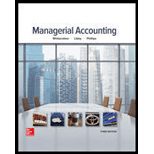
Concept explainers
(a)
Breakeven Point:
The level of sales where the company is neither on profit nor loss is termed as breakeven point. In other words, that level of sales at which the fixed cost of the business is recovered.
To compute:
The breakeven point if the fixed cost is
Answer to Problem 22E
The breakeven point is
Explanation of Solution
Fixed cost is
Contribution margin is
The break-even point in units is calculated as:
(b)
Concept introduction:
Breakeven Point:
The level of sales where the company is neither on profit nor loss is termed as breakeven point. In other words, that level of sales at which the fixed cost of the business is recovered.
To prove:
The breakeven point by using contribution margin statement.
Answer to Problem 22E
The breakeven point is
Explanation of Solution
Income Statement:
| Particulars | Amount |
| Sales Price |
|
| Variable Cost per Canoe |
|
| Contribution Margin |
|
| Less: Fixed Cost | |
| Profit |
(c)
Concept introduction:
Target Profit:
The target profit is that profit which a company decides to achieve and this analysis helps in determinig the level of sales by which this target can be achieved.
The total sales to achieve target profit of
Answer to Problem 22E
The target sale point is
Explanation of Solution
Fixed cost is
Contribution margin is
The total sales for achieving the target profit are calculated as:
(d)
Concept introduction:
Target Profit:
The target profit is that profit which a company decides to achieve and this analysis helps in determinig the level of sales by which this target can be achieved.
To prove:
The target sale by using contribution margin statement.
Answer to Problem 22E
The target sale is
Explanation of Solution
Income Statement:
| Particulars | Amount |
| Sales Price |
|
| Variable Cost per Canoe |
|
| Contribution Margin |
|
| Less: Fixed Cost | |
| Profit |
(e)
Concept introduction:
Margin of Safety:
The margin of safety is the margin enjoyed by the company which is achieved over and above the breakeven sales. It is a difference of actual sales and breakeven sales.
To compute:
The margin safety in units and percentage of sales.
Answer to Problem 22E
The margin safety is
Explanation of Solution
The actual sales amount to
The breakeven sales amount to
The margin of safety in terms of amount is calculated as:
The margin of safety in terms of percentage of sales is calculated as:
Want to see more full solutions like this?
Chapter 6 Solutions
Managerial Accounting
- Last year, Parker Industries' cash account decreased by $22,000. Net cash provided by investing activities was $18,000, and net cash used in financing activities was $12,000. What was the net cash flow provided by (used in) operating activities on the statement of cash flows?arrow_forwardNeed solution urgently basis no ai.arrow_forwardI need help with accountingarrow_forward
 Managerial Accounting: The Cornerstone of Busines...AccountingISBN:9781337115773Author:Maryanne M. Mowen, Don R. Hansen, Dan L. HeitgerPublisher:Cengage Learning
Managerial Accounting: The Cornerstone of Busines...AccountingISBN:9781337115773Author:Maryanne M. Mowen, Don R. Hansen, Dan L. HeitgerPublisher:Cengage Learning Managerial AccountingAccountingISBN:9781337912020Author:Carl Warren, Ph.d. Cma William B. TaylerPublisher:South-Western College Pub
Managerial AccountingAccountingISBN:9781337912020Author:Carl Warren, Ph.d. Cma William B. TaylerPublisher:South-Western College Pub Cornerstones of Cost Management (Cornerstones Ser...AccountingISBN:9781305970663Author:Don R. Hansen, Maryanne M. MowenPublisher:Cengage Learning
Cornerstones of Cost Management (Cornerstones Ser...AccountingISBN:9781305970663Author:Don R. Hansen, Maryanne M. MowenPublisher:Cengage Learning


